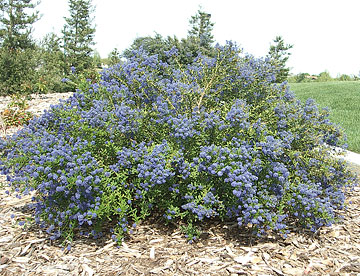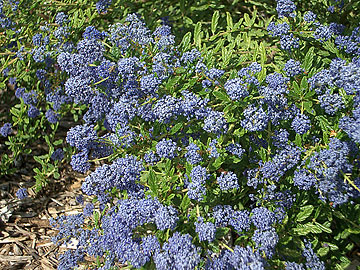Salinity Management Guide

Palms, most being tropical plants, grow well in Los Angeles’s mild climate.
Climate-based guides for selecting species of plants
Climate zone-based plant-selection guidebooks can be immensely helpful when selecting trees, shrubs, ground covers, and turfgrasses for landscapes in California. Two such guidebooks are described briefly below. Each contains information that covers both native and non-native species.
- Sunset Western Garden Book (7th edition, 2001): One of the best-known and most widely available plant-selection guides, this book is based on a system of climatological zones and related maps. The climate zone maps in this source are more refined and more detailed than those in the other selection guides available.
The first part of the book includes the maps and descriptions of the climatological zones. Next in the book is a section listing plants for specific landscaping situations — for example, plants for seacoast gardens, plants for shady areas, and plants for windy areas. The third and main part of the book consists of an encyclopedia describing several thousand species of plants used for landscapes throughout the western United States. Using this book to select plants involves first consulting the appropriate zone map and the lists of plants for specific landscape situations, then consulting the encyclopedia.
- Landscape Plants for Western Regions, by Bob Perry (1992), is perhaps the most design-oriented plant guide available. Essential reading for California landscape designers, especially for those working on southern California landscapes, it contains considerable information on plants and ecological guidelines, plus climate-zone-based maps and associated plant lists. The book's second section, Regional Characteristics, is a good place to start when beginning the plant-selecting phase of designing a landscape. The book's final section, Illustrated Plant Compendium, describes in detail 475 species of plants. Each description includes one or more clear, well-composed color photographs.
The full bibliographic citations for the Sunset Western Garden Book and Landscape Plants for Western Regions are provided at the end of this module.
Another map of zones, the U. S. Department of Agriculture's map of hardiness zones, is available online. One link where that map is available is www.usna.usda.gov/Hardzone/ushzmap.html, which is part of the United States National Arboretum's website.

Most species of Ceanothus (wild lilac) are native to California and grow well in Zones 1 through 9 and 14 through 24.
Once your landscape's zone is pinpointed, then your list of possible plants can be further winnowed according to their suitability to the mesoclimate — the climate of the neighboring area — and to the microclimate — the climate of the immediate area, which can be affected by nearby heat-emanating pavement and buildings in urban areas, hedges and fences that disrupt the movement of air, and the like.
Precipitation and temperature, including the length of the growing season, are most commonly the limiting climatic factors. Too much or too little water can be offset by changes in irrigation, drainage, and other practices. However, temperature remains the least controllable environmental factor in landscapes. And keep in mind that a number of plants have different optimal temperatures at different stages of growth.
The more you know about the possible plants on your list, the better you'll be able to select those most suited to the local climate. To increase your knowledge, you could consult the aforementioned two books, as well as the books American Horticultural Society Encyclopedia of Plants and Flowers, American Horticultural Society A to Z Encyclopedia of Garden Plants, and Flora: A Gardener's Encyclopedia. Books on this topic number in the hundreds. Some pertinent information is also available online. For example, the website of the U.S. Department of Agriculture's Natural Resources Conservation Service includes such information at http://plants.usda.gov.

Ceanothus thrives in full sun. It requires some water when grown inland, yet little or none when grown near the coast. Many of the species are said to be salt-tolerant.
While referring to books and web pages, also gather other types of information useful for narrowing down the choice of plants for your landscape, such as: rate of growth, longevity, and ultimate size; resistance to pests and diseases; maintenance requirements, including any information regarding compatibility with the irrigation water's chemistry, including salt tolerance, as well as compatibility with methods of irrigation; and invasiveness, as some species have the ability to reproduce and spread beyond the planting area, which might make their limited use advisable.
| « Previous page | Next page » |